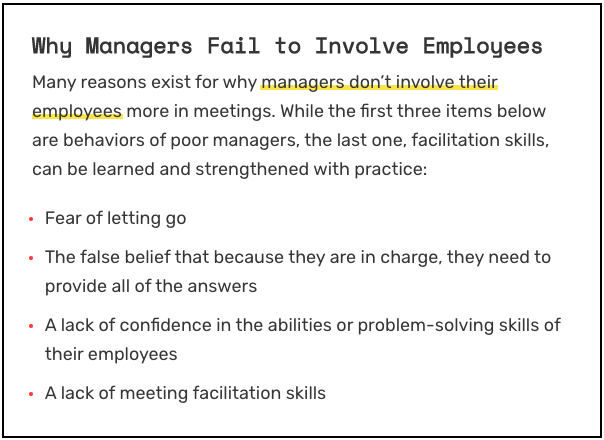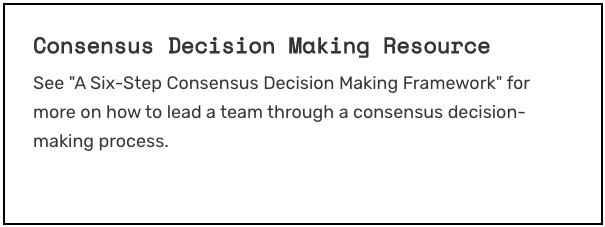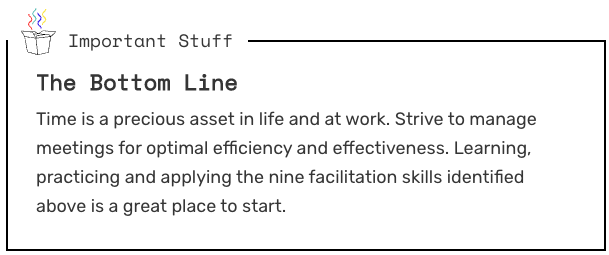Meetings can either be opportunities to share ideas, discuss challenges and define action plans, or they can end up as unproductive time wasters. Unfortunately, managers are often the major contributors to meeting process dysfunction. You need skills to run meetings properly.
Strengthening Your Meeting Facilitation Sklills
By definition, facilitating means, “To make easier or less difficult; help forward.” For a manager to facilitate a meeting (instead of running it), they need to be willing to let go of their power and be open to different outcomes and approaches.
Where Managers Go Wrong With Meetings
Many managers think they know how to “run” a meeting. They set the agenda, do all of the talking, and make all of the decisions. While this may feel easy and efficient for managers, it’s often a waste of people’s time, and it doesn’t tap into the creative potential of the team.
In fact, it has the opposite effect as employees tend to withdraw, deferring to the manager who wants to be in charge.

These ideas for managers at all levels will strengthen their meeting facilitation skills in support of improving meeting productivity.
Skills Managers Need to Facilitate Meetings
Proper meeting facilitation involves getting everyone at the meeting involved in identifying and solving problems. Teams will almost always develop better, more creative solutions than any manager could alone. Teams are also more likely to support the implementation of the solutions they helped create. You can break these meeting facilitation skills down into three different categories:
- Planning a Meeting
- Conducting a Meeting
- Resolving Meeting Problems
How to Plan a Meeting
Before you begin any meeting you need an agenda. For a collaborative meeting, invite meeting attendees to tell you what problems the team needs to solve or what changes the team needs to pursue. Make sure the topics are ones that allow for group participation. Facilitating a meeting is different than presenting information at a meeting.
1. Enable Group Involvement
Make sure you allow ample time for group involvement and that you don’t try to solve too many problems in a short time period. However, too much time can also result in an endless cycle of “well what about....” Make sure your agenda meets the time allotted for the meeting. Skills needed include these.
- Group Facilitation Skills
- Meeting Planning
- Problem Solving
- Decision Making
- Agenda Development
2. Make Sure You Provide Proper Logistics
Choose your meeting location and time carefully. If you try to cram 15 people into a conference room with six chairs, the meeting will be a disaster. When people are uncomfortable, can’t see each other, can’t hear, or are hungry, meeting results will suffer.
Learn how to use logistics as a way to encourage great participation and remove barriers. You need to plan all of this in advance. Sending someone out mid-meeting to order sandwiches makes your meeting less effective. Logistics planning involves these skills.
- Logistics Planning and Experience
- Decision Making
- Thoughtful Consideration of the Needs of Others
3. Recording the Meeting Minutes
The last critical part of planning a meeting is the meeting minutes. Who will take them? Who will distribute them? If you don’t have a designated administrative person, consider doing them yourself or rotate the responsibility among the team members. If Jane did the minutes last week, it’s John’s turn this week. If you’re using a whiteboard or a flip chart to collect ideas, give the person writing enough time to document them correctly.
- Note-Taking Skills
- Documentation Relevance
- Understanding Diversity and Inclusion
How to Conduct a Meeting
With your solid agenda, good location, and appropriate refreshments, you are ready for your meeting. To make your meeting a great working meeting (and not just an information dump), you will need to demonstrate appropriate meeting facilitation skills.
To do this, you will want to focus on these three components of meeting facilitation.
1. Ask Questions
Great questions stimulate great discussion. The article, “70 Awesome Coaching Questions Using the GROW Model," offers some outstanding discussion prompters.
- Ask questions to gain additional information
- Ask questions to learn about different viewpoints
- Ask questions to note areas of agreement and disagreement
- Ask questions to confirm that you are really hearing exactly what team members are contributing
- Ask questions to ascertain that you are sharing meaning with team members
2. Demonstrate Active Listening
Active listening allows you to really and deeply know that you and the person you are listening to share meaning and have come to a thoughtful understanding of each other’s positions. When you paraphrase, check for understanding, and ask follow-up questions, it encourages more participation and keeps the discussion flowing.
- Make head nodding and other appropriate gestures to indicate understanding
- Repeat what you heard back to the other party so that you know you share meaning
- Ask questions to clarify anything you are uncertain about
- Ask follow-up questions to further expand your understanding
- Use words such as “ah-ha,” “yes, I understand,” and the like to indicate understanding
3. Lead a Proper Brainstorming Session
Most people think they already know how to brainstorm. However, they usually don’t. In too many settings, the effectiveness of brainstorming is reduced by poor process management, strong social or political pressures and poor facilitation skills. Many people have never truly experienced the power of a well-run brainstorming session.
- Practice effective facilitation skills
- Manage the introduction of ideas by participants
- Make certain that all participants have an equal opportunity to speak
- Manage competing conversations and people talking over one another
- Devise an effective way to narrow down the brainstormed choices to a manageable number
- Resolve any conflicts that arise
How to Solve Problems in a Meeting
The second type of meeting requires different meeting facilitation skills. You wouldn’t need to meet if everyone already agreed on the solution. You come together to share information and develop answers and this means you’ll need to bring people together. Here are the skills you’ll need.
1. Consensus-Building Skills
Consensus does not mean that everybody has to agree with a decision. It means that everyone has had an opportunity to share their perspectives (potentially by brainstorming) and propose ideas. Following this, the key to consensus is that all team members agree to support the direction even if it was not their original choice.
- Proper meeting facilitation will guide the group from idea sharing to the development of an effective decision.
- Reaching consensus takes more time, but will usually gain stronger buy-in from the group at large. However, remember that consensus is not the ultimate goal.
- An effective decision for the problem at hand is the most important issue.

2. Conflict Resolution Skills
Whenever there is a roomful of people involved in solving a problem, conflict is inevitable. In fact, conflict over the task or issue is viewed by team researchers as part of the process for effective decision-making. A manager must learn how to harness the power of conflict in a positive way.
- Manage the discussion to listen to all viewpoints
- Lead the discussion to identify areas of agreement and disagreement
- Use facilitation skills to make certain participants feel heard out
3. Non-Verbal Communication Skills
While researchers argue over the exact percentages, most would agree that more than 50% of communication is non-verbal.
- A manager needs to be able to read the group’s tone and body language to assess their level of engagement, candor, and commitment.
- Your understanding of non-verbal communication can help see when there is true agreement versus spoken agreement just to finish the meeting.
- Be cognizant of body language as a way to experience the total communication voice of an individual or a team.

The original article was written to Liveabout dotcom. You can read the original at: https://www.liveabout.com/meeting-facilitation-skills-2275915